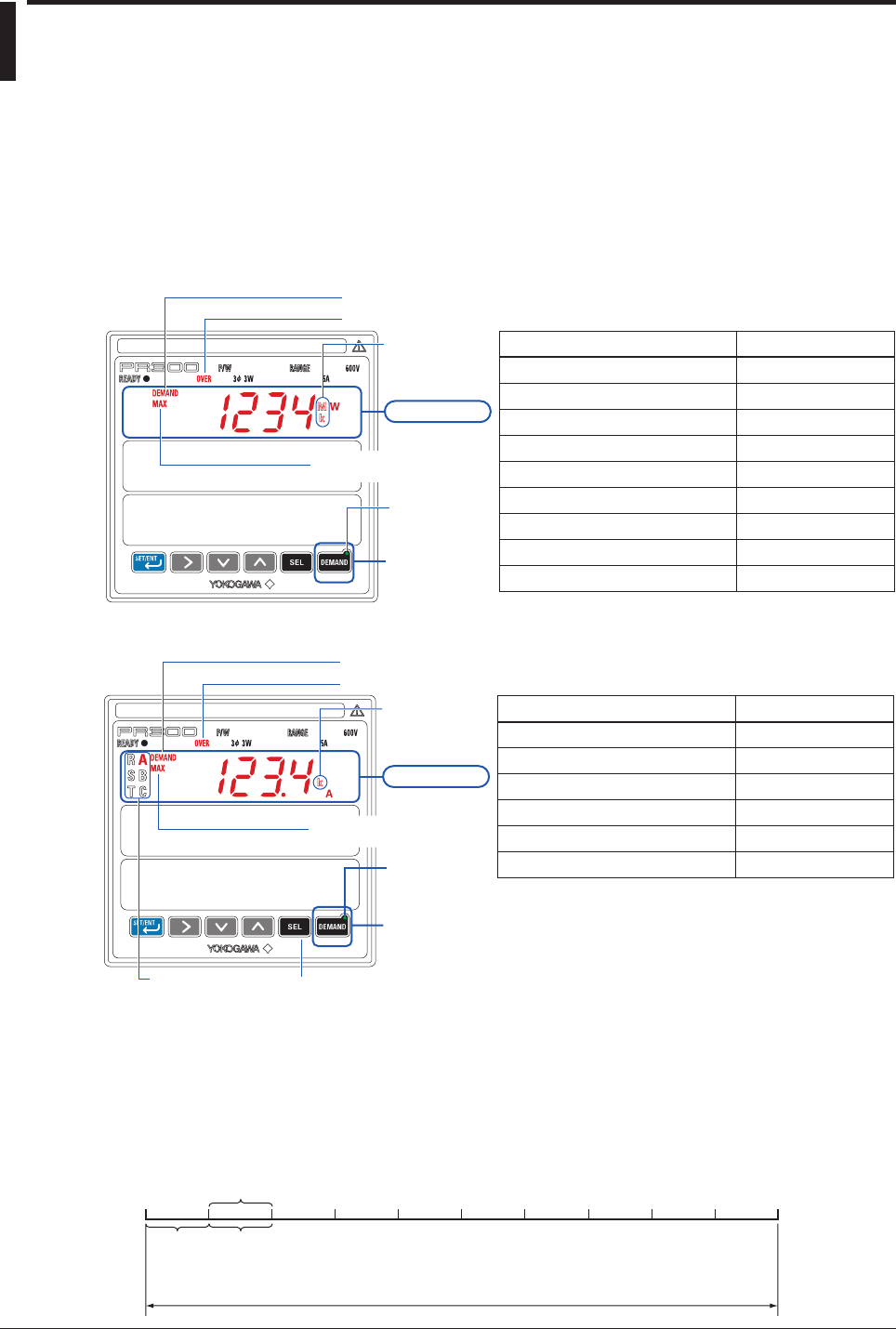Energy Meter Manual
Table Of Contents
- Introduction
- Notices
- Checking the Package
- Checking the Model and Suffix Codes
- Contents
- Chapter 1 Installation and Wiring
- 1.1 Installation with the ANSI 4-inch Round Form or JIS 110-square Instrument Size
- 1.2 Installation with the DIN 96-square Instrument Size
- 1.3 Wiring
- Crimping Terminal Recommendations
- Single-phase two-wire system (voltage input, current input, power supply)
- Single-phase three-wire system (voltage input, current input, power supply)
- Three-phase three-wire system (voltage input, current input, power supply)
- Three-phase four-wire system (voltage input, current input, power supply)
- Three-phase four-wire system (2.5 element) (voltage input, current input, power supply)
- Other Wiring
- 1.4 Attaching the Dust Cover and Terminal Cover
- Chapter 2 Preparations before Starting Measurement (Set up the PR300 First)
- Chapter 3 Parameter Setting Operations
- 3.1 Basic Parameter Setting Operations
- 3.2 Setting the VT and CT Ratios
- 3.3 Setting the Integrated Low-cut Power
- 3.4 Setting RS-485 Communication Conditions
- 3.5 Setting Ethernet Communication Conditions
- 3.6 Setting Pulse Output Conditions
- 3.7 Setting Analog Output Conditions
- 3.8 Setting Demand Measurement Conditions
- 3.9 Setting the Measured Value Display Pattern
- 3.10 Setting the “Indicator-out” Mode and Locking Parameters
- Chapter 4 Operation for Display of Measurement Items and Measurement Method
- 4.1 Measurement Items
- 4.2 Switching Display Pattern
- 4.3 Displaying Measured, Instantaneous, and Maximum/Minimum Values
- Example Display and Measuring Ranges of Active Power (Regenerative Power)
- Example Display and Measuring Ranges of Reactive Power
- Example Display and Measuring Ranges of Apparent Power
- Example Display and Measuring Ranges of Voltage
- Example Display and Measuring Ranges of Current
- Example Display and Measuring Ranges of Power Factor
- Example Display and Measuring Ranges of Frequency
- How to Switch between Instantaneous Value, Maximum Value, and Minimum Value
- 4.4 Phase Switching for Voltage and Current
- 4.5 Displaying Energy Values
- 4.6 Resetting Measured Values
- 4.7 Demand Measurement (Optional Measuring Function)
- Chapter 5 Troubleshooting
- Appendix
- Appendix 1 Specifications of PR300
- Measuring Function
- Power Items and Equations
- Input Specifications
- Digital Input Specifications
- Analog Output Specifications (additional output function)
- Pulse Output Specifications (additional output function)
- Demand Alarm Output Specifications (optional measuring function)
- Communication Specifications
- Standard Performance
- Safety and EMC Standards
- Environmental Conditions
- Mounting and Shape
- Appendix 2 System Reset
- Appendix 3 Parameter Map
- Appendix 4 Parameter List
- Appendix 5 Alphanumeric Characters Table for 7-segment LED
- Appendix 1 Specifications of PR300
- Index
- A
- C
- D
- E
- H
- I
- M
- O
- P
- R
- S
- T
- V
- W
- Wiring diagram
- Single-phase two-wire system
- Single-phase three-wire system
- Three-phase three-wire system
- Three-phase four-wire system
- Three-phase four-wire system (2.5 element)
- Analog output
- Demand alarm output
- Demand alarm release
- Ethernet communication
- Integration control signal
- Palse output
- RS-485 communication
- Wiring diagram

4-12
IM 77C01E01-01E
4.7 Demand Measurement (Optional Measuring
Function)
The PR300 (with the demand measuring function) can measure the average power or current during the
set demand period.
This section explains the example display of measured value, measuring range, measurement operation,
and example measurement. For setting conditions related to the demand measurement such as demand
period, refer to Section 3.8, “Setting Demand Measurement Conditions.”
Example Demand Display and Measuring Ranges
Demand power
Start/stop of
demand
measurement
and alarm release
Turns on during
demand
measurement
Turns on during demand alarm
Turns on during demand measurement
Turns on while the
maximum value is displayed
Demand power
Supplementary
unit
(refer to the
table on the right)
Secondary rated power 1.2 VT ratio CT ratio
6 W to less than 100 W
100 W to less than 1 kW
1 kW to less than 10 kW
10 kW to less than 100 kW
100 kW to less than 1 MW
1 MW to less than 10 MW
10 MW to less than 100 MW
100 MW to less than 1 GW
1 GW or greater
Measuring range
0.00 to 99.99 W
0.0 to 999.9 W
0 to 9999 W
0.00 to 99.99 kW
0.0 to 999.9 kW
0 to 9999 kW
0.00 to 99.99 MW
0.0 to 999.9 MW
0 to 9999 MW
Demand current
Start/stop of
demand
measurement
and alarm release
Turns on during
demand
measurement
Turns on during demand alarm
Turns on during demand measurement
Turns on while the
maximum value is displayed
Demand current
Supplementary
unit
(refer to the
table on the right)
Current range 1.2 CT ratio
0.06 A to less than 10 A
10 A to less than 100 A
100 A to less than 1 kA
1 kA to less than 10 kA
10 kA to less than 100 kA
100 kA to less than 1 MA
Measuring range
0.000 to 9.999 A
0.00 to 99.99 A
0.0 to 999.9 A
0 to 9999 A
0.00 to 99.99 kA
0.0 to 999.9 kA
The phase of the demand current
being measured can be switched for display.
Phase indication lamp
Demand Measurement Procedure
Equation: (Pt - Ps) (60 minutes 60 seconds t)
Pt: Current integrated value
Ps: Integrated value at the beginning of the demand period
t: Demand elapsed time (data update period: 10 seconds)
Start demand
measurement
Stop demand
measurement
Demand
period
Average
power
(current)
update
Demand measuring time (while the maximum demand value is retained)
Average
power
(current)
update










